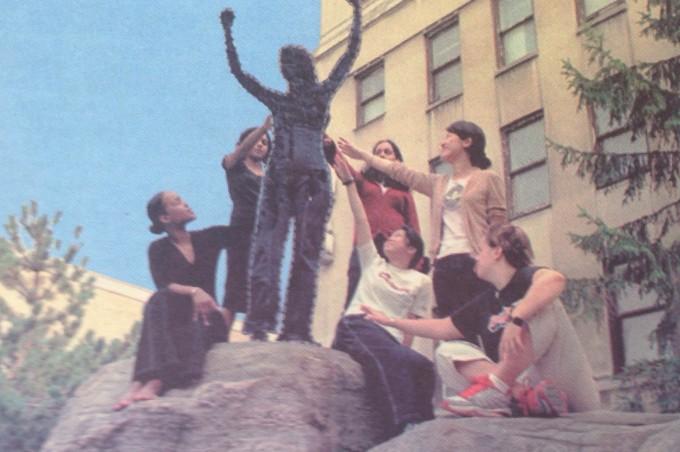By Sheila Nykwist
The F-word has a tarnished image.
As Janet Conway looks around at her class of 77 mostly female students, only seven rise to identify with her question. How many of you call yourselves feminist? It’s the first day of her women, power and politics course at Ryerson this year, and she is surprised at the lack of response. She rewords her question.
“How many of you here,” she asks her students, “support women’s dignity and equality?” All rise.
“There are mixed feelings about declaring yourself feminist,” says Conway. “There has been a big struggle over the last decade about the meaning of feminism.”
It is a struggle that began for the independence of women, drawing large numbers of supporters proudly fighting as feminists. Today, that pride has waned and the collective of feminism dispersed. The question arises, is there still cause of a fight?
“The women’s movement in Canada has weakened considerably in the last 10 years,” says Judy Rebick, CAW-Sam Gindin Chair in Social Justice, who is spearheading the social justice and democracy program at Ryerson.
In the last decade, funding cuts and backlash have weakened the women’s movement, Rebick explains in her recent article Keeping Women’s Issues in Focus. “There is still a need for female advocacy yet government funding is not likely to return,” she writes.
In a study by the National Action Committee on the Status of Women, females represent about 20 per cent of the federal parliament, ranking Canada 19th worldwide. When it comes to paid employment, a woman in Canada earns 73 cents for every dollar earned by a man, placing Canada second only to japan for low-paid women in the industrialized world.
“You still have to be in a man’s world,” says Betty Rigler, peer supporter facilitator at Ryerson.
A decrease in central funding has created competition among NGOs battling to finance programs that establish women’s shelters, transition houses, anti-violence programs, counselling and educational centres.
The latest report from the National Council on Welfare shows women’s poverty rate at 17.4 per cent, the highest in 16 years and higher than during the last two recessions.
“There is a need to organize women,” Rebick says. “I don’t see activity. There is no mas influence.”
What is missing from today’s feminist movements, says Rebick, are political demands, concrete activity and a clear definition of feminism itself.
Without a unified movement, women’s ideas don’t transpire into action, she says.
“The movement is less unified now than it has ever been,” says Angela Failler, professor of women’s studies at York University. “There is still a fear around the F-word.”
Failler’s students tell her they don’t want to sign up for the movement. They just want to learn something more about women’s issues.
Today’s world presents a wide range of issues that address an equally diverse population of women. Gone are the days of one voice, one cause. Feminism now encompasses differences such as class and race, sexual orientation, ability and age.
“In the past, feminism has proven beneficial for some,” says Failler, “largely the white, middle-class women.”
It is this exclusivity that has created criticisms of previous efforts and lead to a scattering of the mainstream white feminist movement, she says.
“White feminists are working with those criticisms in mind,” says Failler. “We have to be critical of feminism in order to keep pushing it forward.”
Another reason for the apparent weakening of the feminist movement is that many women are involving themselves in fights like the anti-racism movement, the anti-globalization movement, the antipoverty movement and efforts to address queer issues.
“This is one reason it has to diversify,” says Failler. “One movement can’t or shouldn’t even try to attend to everyone’s needs.”
The emphasis now is on coalition groups — different groups with similar issues, working together.
Whereas previous movements focused on gaining the right to vote, own land and establish credit, women nowadays fight for equal pay, violence prevention and access to leadership positions in business and government.
In a study done by the National Action Committee on the Status of Women, women are still denied access to jobs in resource management and development of sustainable economic systems.
International efforts to improve these and other women’s issues converged most recently in Beijing in 1995 at the fourth World Conference on Women. It drew representatives from 189 countries, making it the largest UN conference to date.
Conway sees feminism as the most successful movement in history. She says that day care, abortion clinics, shelters, unions and women in higher education, a curriculum that includes women’s studies, all exemplify successes of the feminist movement over the last century.
Clarissa Lo, fourth-year urban planning student at Ryerson, admits to enjoying the fruits of hard-working feminists of the past, yet doesn’t believe the need to fight is as strong as before.
“I can’t credit myself as a feminist,” says Lo who believes feminism defines people who are actively promoting the movement.
Canadian feminists continue their efforts, now making use of advances in technology to gain recognition and success. The internet, videos, art and zines (independently made magazines) are used to spread political messages and radical culture. There is no longer just one audible voice as was the case in past generations, nor one united group moving in step. Diversity of issues has resulted in diversity of efforts.
“I declare myself a feminist,” says Conway. “I think it’s important to own and claim to word.”










Leave a Reply